Dell XPS 13 Review
by Brett Howse on February 19, 2015 9:00 AM EST- Posted in
- Laptops
- Dell
- Ultrabook
- Broadwell-U
- XPS 13
Display
Dell offers two display choices in the XPS 13. The base model comes with an IPS 1920x1080 (Full HD, or FHD) Sharp 1420 panel, with LED backlighting of course. The upgrade is to the Sharp 1421 panel, which increases the resolution to 3200x1800 (QHD+), for 272 pixels per inch. Even 1080p on a 13.3 inch panel is a nice resolution, but the high DPI display really shines, especially in the new Windows 8 environment. Desktop apps can still have some issues with High DPI, but it is becoming less of a problem over time.
Sharp is the maker of all IGZO displays, which we have seen before in a couple of other devices such as the Razer Blade. The big benefit to IGZO (Indium Gallium Zinc Oxide) panels is they allow more light through the display, reducing the power requirements for the backlight. This generally means that we get to keep the full RGB stripe, which should help with color accuracy.
Being able to see both sets of pixels just shows how many more pixels are packed into the High DPI panel. 1080p is around 2 million pixels and 3200x1800 is 5.76 million pixels. It is a big difference and gives a big increase to clarity, but it comes with the cost of increased power usage, despite the IGZO TFT.
Dell has the displays listed as IPS (In-Plane Switching) panels on their spec sheet, and they do not seem to have any of the off-angle color shift of a VA (Vertical Alignment) design. Whatever the display type, it certainly is not TN (Twisted Nematic) so even at extreme angles there is not the loss of contrast associated with those displays. Also, you can see the anti-glare coating on the FHD pixels, which is the distortion shown on the subpixels.
To test the panels, we turn to SpectralCal’s CalMAN 5 software suite, the X-Rite i1Display Pro Colorimeter for brightness and contrast measurements, and the X-Rite i1Pro Spectrophotometer to measure the color accuracy.
One more note about the Dell displays though is that they have an auto-brightness adjustment with no way to disable it. It seems to manifest itself the most, and the most severe, when there are large contrast changes on-screen. For this reason, our automated testing for the color accuracy would not work at all because of the abrupt changes on the screen as it flashed among the various colors. This would cause the screen to go bright and dim and caused some very erroneous readings.
I was able to get around it for the color testing by manually going to on-screen color patterns, however display calibration is impossible with this brightness adjustment so that was skipped. I have contacted Dell to inquire about this issue and will give an update if they get back to me.
Update: Dell has enabled Content-Adaptive Backlight Control, which we have seen in other devices like the Nokia Lumia 930. Dell has let me know they are looking into a way to have the end user disable this feature.
First up is the brightness, contrast, and black levels.
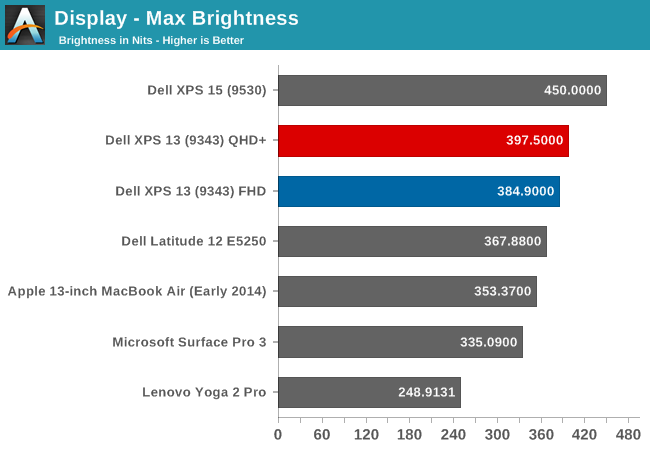
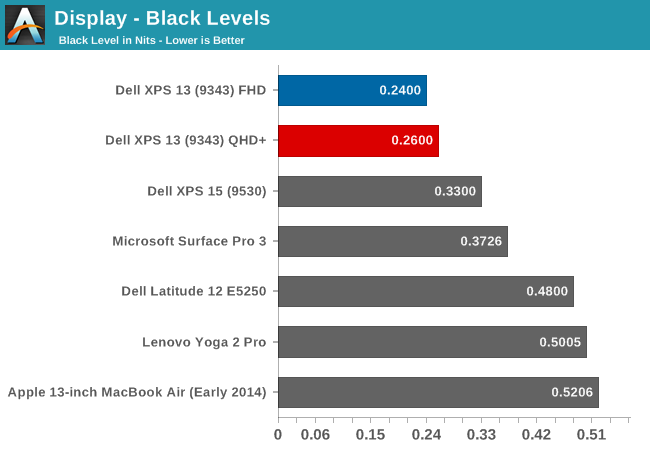
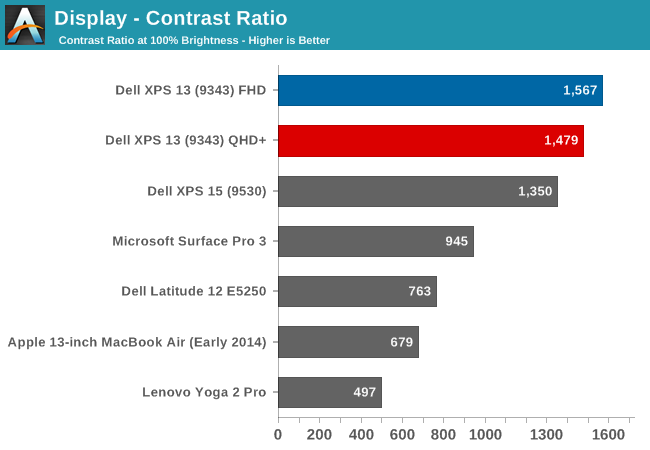
Both displays get very bright. Dell claims 400 nits brightness on the XPS 13 and we measured almost that much. Also, the black levels were very good on both displays, giving a contrast ratio close to 1500:1 on both units. Minimum brightness is around 16-17 nits on both models as well, so there is quite a bit of range on the displays to let them work on almost any situation.


On the QHD+ version, grayscale is a decent result, coming in around delta E of 3. The gamma unfortunately really drops off at the upper end of the range. The color temperature is a bit warm, and as the chart shows, the greens are a bit high. The FHD model does not fare so well, with the gamma going quite high, and the grayscale DE being almost 6.
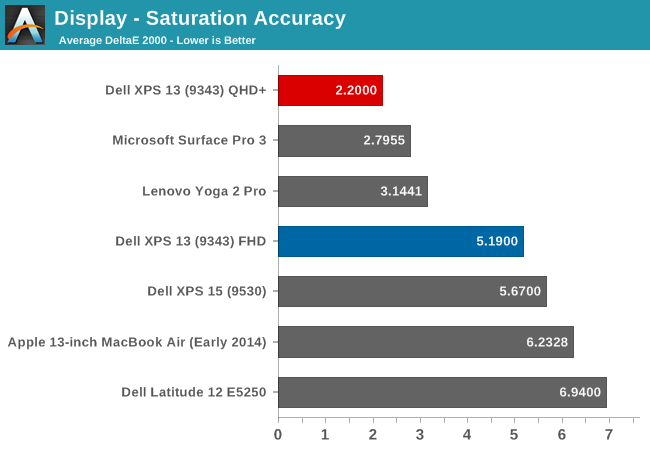
Dell does well on the saturations, with both displays being able to do the entire sRGB color space. Once again, the QHD+ model scores a lot better, with the saturation a very nice 2.2 dE, while the FHD version is closer to 5 - not an awful result, but much worse than the upgraded model.
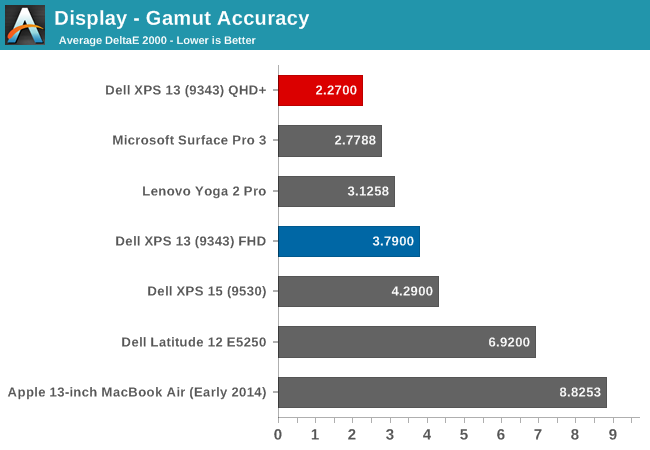
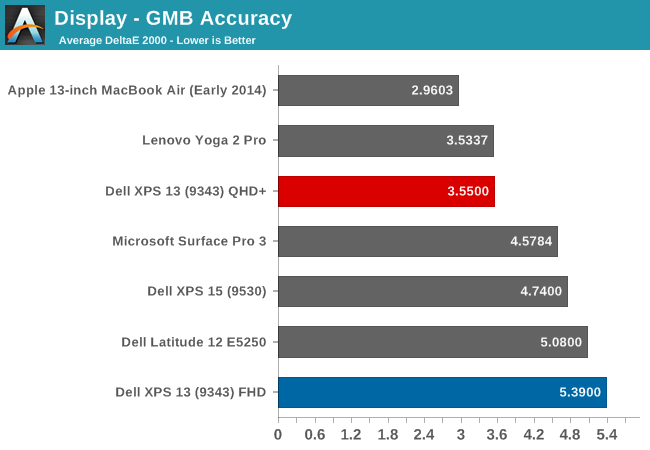
Wrapping up with the Gretag Macbeth results, again the QHD+ model does very well, with the FHD model just average. I have to note though, that even though the GMB score was very good on the QHD+ model, all of the colors that were off, with some of them around DE of 6, were the skin tones. Without calibration, anyone wanting to use this for photo editing may not much enjoy it, and with the auto-brightness issue, the calibration will not work so there is no way to see if the scores improve after calibration.
The Infinity Display is certainly one of the defining characteristics of the XPS 13, and especially with the QHD+ version the color accuracy and other characteristics are quite good. The Auto-Brightness is certainly an issue, and hopefully Dell will offer up a way to disable this either in software or the BIOS soon.


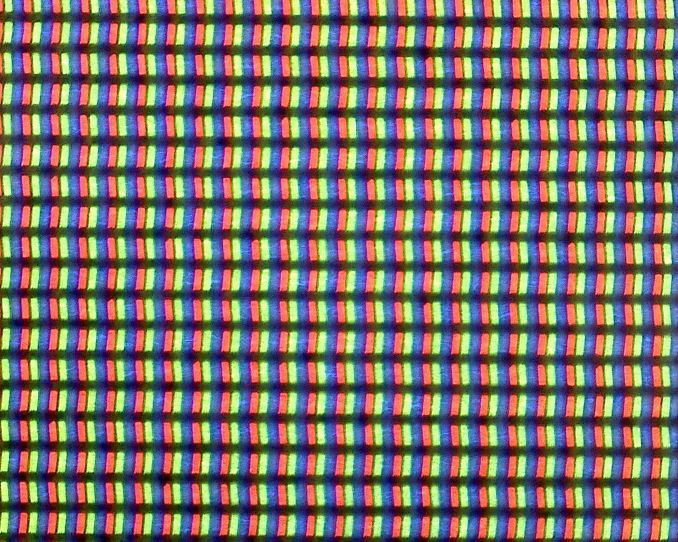
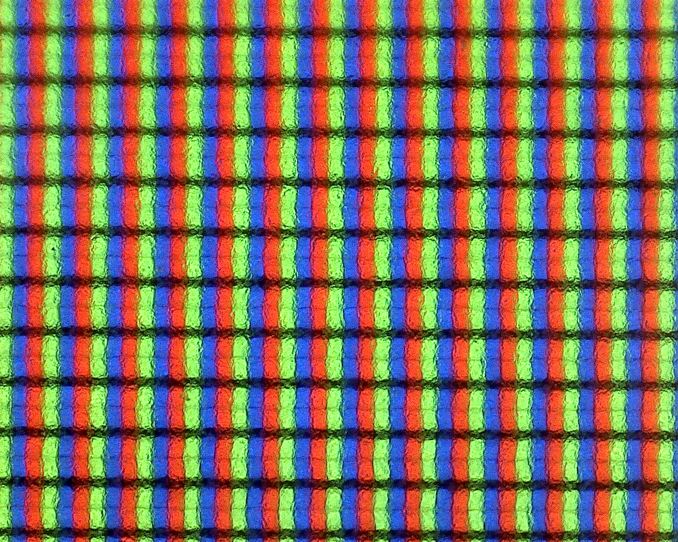
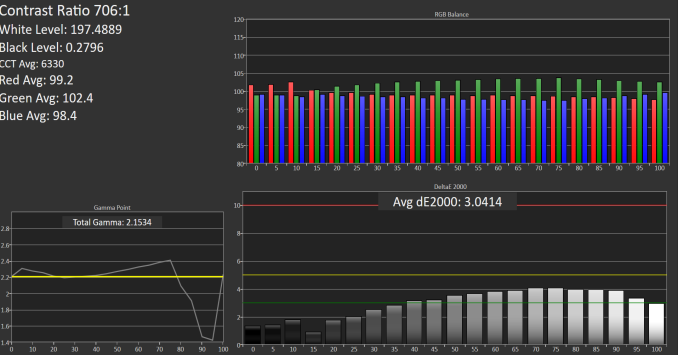
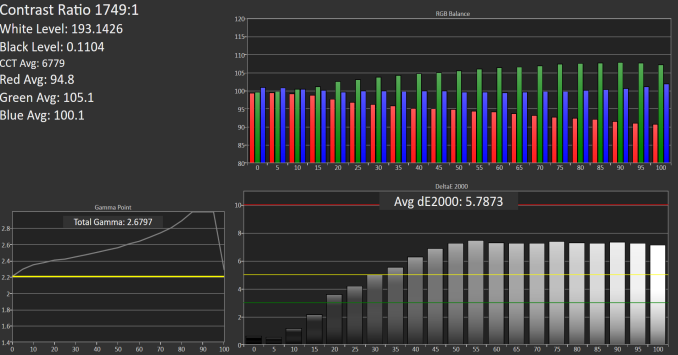
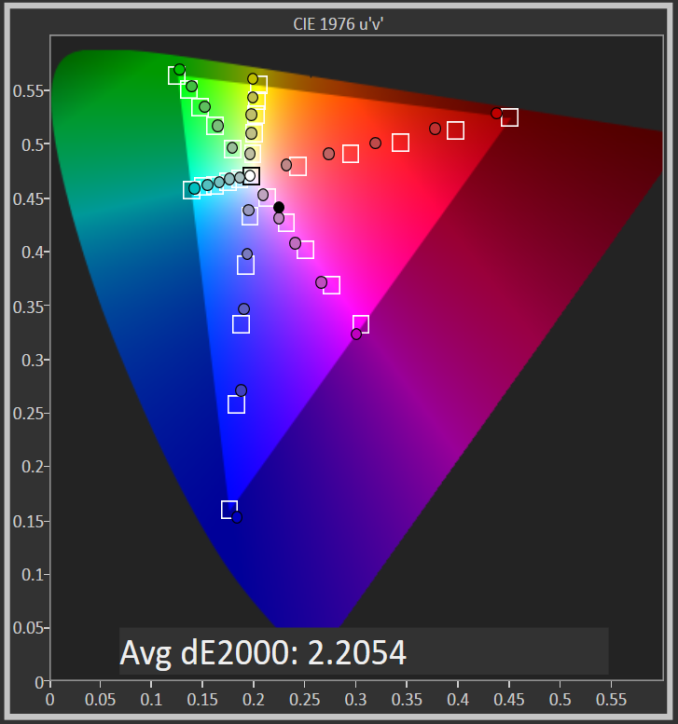

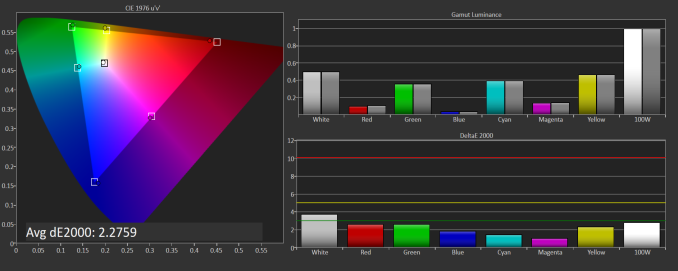
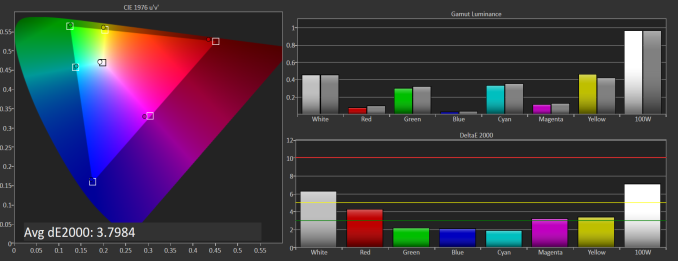

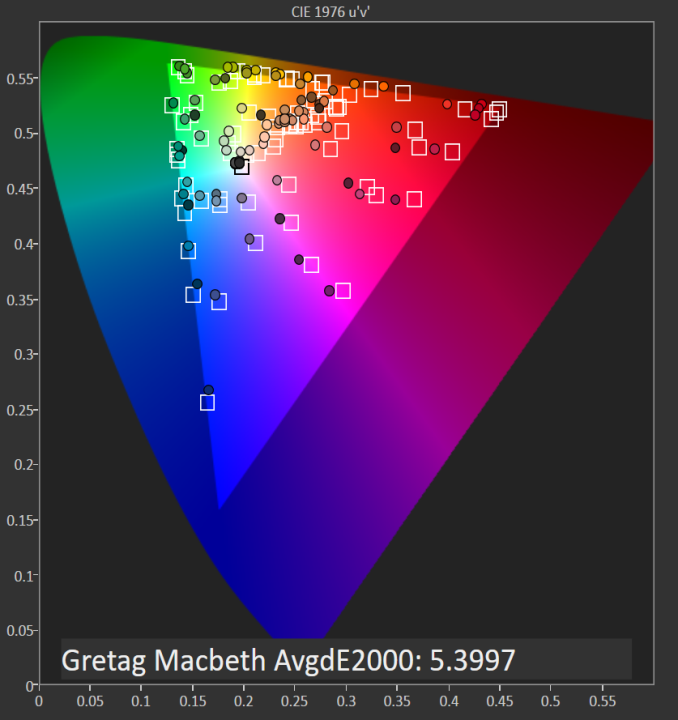








201 Comments
View All Comments
Fedef - Friday, February 20, 2015 - link
I mean, the different brightness level at witch you test the contrast can't be the cause of a contrast dropping from 1500 to 700, it is almost impossible.And even if that were the case you should take that as a reference because none uses their display at max bright unless outdoor in a sunny day.
Brett Howse - Friday, February 20, 2015 - link
The meter we test the grayscale and color accuracy is not accurate at detecting blacks, so the contrast ratio will go down because of the noise in the sensor thinking that there is more light than there actually is, which is why we use a different meter to test contrast. So yes, just ignore that reading since it is incorrect.Fedef - Friday, February 20, 2015 - link
Thanks for clarifing that.Maybe you should just hide those result to avoid confusion.
srdm - Wednesday, April 22, 2015 - link
This is probably a silly question, but I have been wondering if the very good black levels could to some part be due to the adaptive brightness "feature". Is it right that if you measure the black level on a black screen, then the adaptive brightness would lower the brightness and therefore you would see a better black level? Could that have been the case in your measurements?althaz - Thursday, February 19, 2015 - link
This is a pretty awesome Ultrabook. I prefer the form factor of my Surface Pro, but if I were to begin typing on the go a lot more, this would be right at the top of my list I think. Looks even better than the MBA I offloaded!MadMan007 - Thursday, February 19, 2015 - link
Looking at the model lineup...damn, they missed some pretty compelling options. Gimping the FHD screen in memory and SSD (and to a lesser extent CPU) is a damned shame. So what if the price would overlap with the bottom end of the QHD+ models, the battery life of the FHD screen model is insane; I would bet that one with an i5, 256GB or 512GB SSD, and 8GB of RAM would be extremely popular.Nicky Drake - Thursday, February 19, 2015 - link
There is one: I have a Core i5 model with 8GB of RAM and a 256GB SSD. Availability of models varies a great deal between regions though. I'm in New Zealand. I'm loving the matte screen.tipoo - Thursday, February 19, 2015 - link
So what's the secret to the HD Graphics 5500 doing better than the 5000? It's 24EUs @ 300 - 950 (Boost) MHz, vs 40EUs @ 200 - 1100 (Boost) MHz. These things stay at the boost clock while gaming most of the time, so the base freq difference isn't a huge factor. Near half the EUs, lower max clock, and better performance?tipoo - Thursday, February 19, 2015 - link
I know of all the internal improvements to the Broadwell GPUs, but I thought we were expecting like 20% more squeezed out there, not being able to match a higher clocked 40EU part with a lower clocked 24EU part...I wonder what the 48 EU part with eDRAM will perform like then...
peterfares - Thursday, February 19, 2015 - link
Hurrah for RGB and not PenTile garbage!